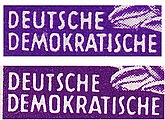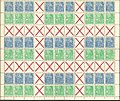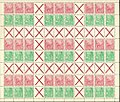Five-year plan (stamp series)

Five-year plan is the name of a definitive series that was issued by the postal administration of the German Democratic Republic between 1953 and 1959. The occasion was the GDR's first five-year economic plan .
The one-penny postage stamp showed hard work in the mine. This was followed, among other things, by the cooperation of workers, farmers and engineers, women in professional life , successes of the GDR in the economy, but also the recovery of workers. The highest value at 84 Pfennig was a family with a dove of peace in front of the skyscraper on Weberwiese near Stalinallee in Berlin. These partly propagandistic representations showed the goal of a peaceful life through the sequence of work, learning, recreation, harvesting what has been achieved.
The stamps were drawn by the graphic artist Erich Gruner. The engraver was Karl Wolf .
Some of these stamps were valid until December 31, 1962. There were a total of 18 different motifs; the Michel stamp catalog distinguishes 62 issues in different variants.
history
The first issue date was August 10, 1953, less than two months after the popular uprising on June 17 . Seventeen motifs appeared in offset printing , the 24 Pfennig stamp was missing. The originally planned book printing could not be published until November 21, 1953 due to production bottlenecks. The brands in offset printing differ from the letterpress edition in that they are of poorer quality; the background was dotted instead of white or hatched, the images washed out. The simplest distinguishing feature, however, is that the stamps appeared in offset printing without the names of the designer and engraver at the bottom of the stamp, while the letterpress editions (Michel numbers 405, 406, 408, 409, 411, 413-416 and 418-422) with the names E. Gruner (left) and K.Wolf (right) were provided.
The transport of a standard letter in domestic traffic at that time cost 24 pfennigs. However, this stamp was only issued in offset printing on November 21, 1953, three months later than the other stamps. Originally, Walter Ulbricht was to be represented; At that time he was the deputy chairman of the GDR Council of Ministers and from 1953 first secretary of the Central Committee of the SED . Although Ulbricht actually determined the political direction in the GDR, he officially only had third place according to the constitution after President Wilhelm Pieck and Prime Minister Otto Grotewohl ; a postage stamp with his portrait did not appear until 1961. However, on April 15, 1953 , a draft of this stamp was shown on the cover of the specialist newspaper for philately and other collecting areas of the GDR, the Collector Express . In the definitive series issued there was no evidence of the SED as the leading party or of politically active persons.
The motif of Stalinallee was chosen as a replacement for the planned Ulbricht brand . In the course of de-Stalinization , this street was renamed Karl-Marx-Allee on November 13, 1961, the last stamp with this motif was withdrawn from counter sales three days later; It was valid until May 31, 1962.
Due to a reduction in postage, many of these stamps were no longer required from October 1, 1954. Eight motifs from the letterpress edition were printed with a new value. A few sheets of the 24-Pfennig stamp in offset printing were also accidentally overprinted. About 600 individual stamps have been preserved; these are among the most sought-after postage stamps in the GDR. Of these eight motifs, the six highest values were reissued from January 22, 1955 with the now valid postage.
Nine postage stamps (Michel numbers 406, 415-416 and 453-458) were printed from January 1957 with changed watermarks .
The last change to this definitive series took place in July 1959; it was the 10-pfennig postage stamp with the same motif as in 1953. In this issue there was no reference to the graphic artist and the engraver at the bottom of the stamp.
The Task Force against Inhumanity put counterfeit stamps of six values of the series ago that differed wanted from the originals: The state name was changed to un undemocratic REPUBLIC and also the location descriptions were modified and provided with political messages, such as "Bad Elster - Bad to the Workers ”in“ Bad Elster - Bad der Bonzen ”or“ Berlin - Stalinallee ”in“ Berlin - Stalinallee Strasse des 17. Juni ”.
Reprint and reprint
The GDR postage stamps were often sold to foreign collectors in exchange for foreign currency ; the lock values are an example. The definitive stamps that are often present were also part of it.
In 1957, all previously issued motifs in this definitive series were reissued with an edition of 20 million copies per stamp. In order to prevent speculation , the overprinted 24-pfennig postage stamp was also reprinted in offset printing with an edition of two million copies. Using quartz light you can still easily distinguish the original stamp with overprint from the subsequent edition, because the original edition glows in a rich orange or light red under the test lamp (Michel number 439 aII g XI), while the subsequent edition (Michel number 439 bII g XI) "Quarzt" carmine red. However, a mistake was also made in the reprint, as few switch sheets were printed on watermark 2 XII paper.
The original printing plates of the letterpress editions were still available for it (in philately this is called a reprint ). For the postage stamps in offset printing, the plates that no longer exist had to be made anew, this is a reprint that differs slightly from the original stamps .
The main distinguishing feature here is also easily recognizable for the layperson: Each brand bears the national designation GERMAN (paragraph) DEMOKRATISCHE REPUBLIK. The first edition, produced in offset printing, uses unscaled capital letters with the second "E" from DEUTSCHE above the "AT" from DEMOKRATISCHE; in addition, the letters are relatively slim. The reprint, on the other hand, shows a somewhat bold font with the "E" exactly above the "A". The cliché series were all printed on ungummed paper. If you look closely, you can see the irregular perforation and the poor tearing of the paper (frayed teeth occur).
These pieces of the reprint series, intended purely for stamp collectors, were canceled with printed stamps. Philatelists refer to this as "advance cliché evaluation", in which the complete counter sheet was completely overprinted with stamps. Each stamp covered four stamps. In a sheet of 10 × 10 stamps there were 25 stamps; Due to the almost quarter-circle imprint, these prints are easy to recognize on the basis of their absolute regularity (no canting, squashing of the stamp, always the same stamp date, "fictitious" post offices).
The stamps printed include: Cottbus 1 , Dresden N25 , Erfurt 1 , Gera 4 , Halle (Saale) 2 , Karl-Marx-Stadt C1 and 4 , Leipzig C1 and O5 , Magdeburg BPA 7 , Potsdam 1 , Rostock 2 and Schwerin ( Meckl) 1 . The respective stamp date was between January 1 and December 17, 1956.
List of issues and motives
There are different variants of the motifs issued in the “Five Year Plan” series. Some of these have an indication of the draftsman and engraver below the picture, different perforations , different watermarks or slightly different colors. In addition to the normal sheet edition of these stamps, there were some motifs as stamp booklets or as rolls. The wide upper and lower margins of the sheet stamps were provided with scrolls and the inscription Invalid Werthlos in the brand color .
|
Picture (with Michel catalog numbers) |
Values in pennies |
Description Michel catalog (FRG), among it Lipsia catalog (GDR) |
Issue from | Date of Expiry | |||||
| pressure | Overpressure | New edition | Offset printing letterpress overprint (letterpress) new edition 1957 |
||||||
| Offset | Buchdr. | Offset | Buchdr. | 1957 | 1959 | ||||
 362 |
 405 |
- | - | - | - | 1 |
Coal miner , miner |
August 10, 1953 November 21, 1953 - - |
March 31, 1959 March 31, 1959 - - |
 363 |
 406 |
- | - |
 577A |
- | 5 | Woman on the column wheel, woman on the column wheel |
August 10, 1953 December 28, 1953 - March 1957 |
December 31, 1962 December 31, 1962 - December 31, 1962 |
 364 |
 407 |
- |
 435 |
- | - | 6, later 5 |
Workers from East and West join hands, unity |
August 10, 1953 November 21, 1953 October 1, 1954 - |
March 31, 1959 March 31, 1959 May 31, 1962 - |
 365 |
 408 |
- |
 436 |
- | - | 8, later 5 |
Learning youth, behind picture of Karl Marx , learning youth |
August 10, 1953 December 28, 1953 October 1, 1954 - |
March 31, 1959 March 31, 1959 May 31, 1962 - |
 366 |
 409 |
- | - | - |
 704A |
10 | Workers share experiences, workers
|
August 10, 1953 November 21, 1953 - - |
December 31, 1962 December 31, 1962 - - |
 367 |
 410 |
- |
 437 |
 578A |
- | 12, later 10 |
Farmer , artisan , intellectual , farmer, worker and representative of the intelligentsia |
August 10, 1953 November 21, 1953 October 1, 1954 January 1957 |
March 31, 1959 March 31, 1959 May 31, 1962 December 31, 1962 |
 368 |
 411 |
- | - | - | - | 15th | Woman at the teleprinter , teleprinter |
August 10, 1953 January 25, 1954 - - |
December 31, 1962 December 31, 1962 - - |
 369 |
 412 |
- |
 438 |
 579A |
- | 16, later 15 |
Steel smelters, smelter , ironworkers |
August 10, 1953 November 21, 1953 October 1, 1954 early 1957 |
March 31, 1959 March 31, 1959 May 31, 1962 December 31, 1962 |
 370 |
 413 |
- | - | - | - | 20th | Workers in front of Kurhaus Bad Elster , Bad Elster |
August 10, 1953 February 6, 1954 - - |
December 31, 1962 March 31, 1959 - - |
 371 |
 414 |
 439bgXI |
 439aIm |
 580A |
- | 24, later 20 |
Stalinallee , Berlin, Stalinallee, Berlin
|
November 21, 1953 December 28, 1953 October 1, 1954 May 1957 |
March 31, 1959 March 31, 1959 May 31, 1962 May 31, 1962 |
 372 |
 415 |
- | - |
 581A |
- | 25th | Workers during the reconstruction of a class 52 s steam locomotive . Note 3 , railroad |
August 10, 1953 November 21, 1953 - early 1957 |
December 31, 1962 December 31, 1962 - December 31, 1962 |
 373 |
 416 |
- | - |
 582A |
- | 30th |
Folk dance group , folk dance |
August 10, 1953 November 21, 1953 - early 1957 |
December 31, 1962 December 31, 1962 - December 31, 1962 |
 374 |
 417 |
- | - | - | - | 35 |
German sports hall in the Stalinallee, Berlin, Sporthalle Berlin |
August 10, 1953 November 21, 1953 - - |
March 31, 1959 March 31, 1959 - - |
 375 |
 418 |
- | - | - | - | 40 |
Chemist , chemical plant , chemist |
August 10, 1953 February 15, 1954 - - |
December 31, 1962 December 31, 1962 - - |
 376 |
 419 |
- |
 440 |
 583A |
- | 48, later 40 |
Zwinger , Dresden , Zwinger, Dresden |
August 10, 1953 December 28, 1953 October 1, 1954 early 1957 |
March 31, 1959 March 31, 1959 May 31, 1962 December 31, 1962 |
 377 |
 420 |
- |
 441 |
 584A |
- | 60, later 50 |
Ocean-going ship on stack , shipbuilding |
August 10, 1953 November 21, 1953 October 1, 1954 May 1957 |
March 31, 1959 March 31, 1959 May 31, 1962 December 31, 1962 |
 378 |
 421 |
- | - | - | - | 80 |
Combine harvester , combine harvester |
August 10, 1953 November 21, 1953 - - |
December 31, 1962 December 31, 1962 - - |
 379 |
 422 |
- |
 442 |
 585A |
- | 84, later 70 |
Family, skyscraper on Weberwiese , Berlin, fight for peace |
August 10, 1953 November 21, 1953 October 1, 1954 early 1957 |
March 31, 1959 March 31, 1959 May 31, 1962 December 31, 1962 |
- Note 1: Edition from July 1959, valid until December 31, 1962
- Note 2: Edition from March 16, 1955, valid until May 31, 1962
- Note 3: The description in the Michel catalog is controversial as the reconstruction of the BR 52 in the GDR only began in 1960
Stamp booklets
The first three stamp booklets of the GDR only contained stamps from the five-year plan . The issue price was two marks each; however, the composition of the stamps was different. All consisted of three stamp booklet sheets, two rows of three stamps each were printed per sheet. These stamp booklets had a separable margin. There could be a sheet of advertising between the stamps. The stamp booklet sheets (H sheets) are numbered consecutively in stamp catalogs according to the date of issue.
- Markenheft 1 (issue from March 1955) and Markenheft 2 (issue from September 1957); the difference between the stamps is the new watermark
- Sheet 1: upper stamps: three times 10 Pf. (Michel No. 453); lower stamps: three times 5 Pf. (Michel no. 406)
- Sheet 2: upper stamps: three times 20 Pf. (Michel no. 455); lower stamps: three times 5 Pf. (Michel-No. 453)
- Sheet 3: upper stamps: twice 10 Pf. (Michel No. 453), once 20 Pf. (Michel No. 455); lower brands identical
- Brand booklet 3 (edition from December 1960)
- Sheet 1: all stamps: 5 Pf. (Michel no. 577; motif corresponds to 406 with new watermark)
- Sheet 2: all stamps: 10 Pf. (Michel no. 704)
- Sheet 3: upper stamps: three times 20 Pf. (Michel No. 580; motif corresponds to 466 with new watermark); bottom row twice 20 Pf. (Michel-No. 580) and once 10 Pf. (Michel-No. 704)
- Stamp booklet 3 of the GDR
Stamp booklet sheet
Each stamp booklet sheet (MHB) contains nine identical H-sheets, perforated horizontally and vertically, with dividers printed with red St. Andrew's crosses .
MHB 1 with 5 and 10 pfennigs, face value: 4.05 DM
literature
- “Five Year Plan.” What to Know About This Series. In: Deutsche Briefmarken-Revue , issue 1/1990
- P. Tichatzky: The permanent editions of the GDR "Motive of the five-year plan" , series of publications on the GDR collection area, issue 3, 1999, 190 pp.
Web links
- The five-year plan navigator ( Memento from March 26, 2010 in the Internet Archive ) Possibility to identify the various issues (PDF; 540 kB)
- Mail for you from the Junge Briefmarkenfreunde Stadt Berlin ( Memento from March 26, 2010 in the Internet Archive ) The definitive series “Five Year Plan” (PDF; 1.25 MB)
Individual evidence
- ↑ Information about the stamp engraver Karl Wolf
- ^ Michel catalog Germany 1999/2000 (paperback), publisher: Schwaneberger Verlag GmbH (1999), ISBN 3-87858-028-2
- ^ Image of the planned brand with Walter Ulbricht
- ^ Michel Germany Special Catalog 2006
- ↑ Deutsche Post: Income from foreign currency by selling stamps to collectors ( memento of March 26, 2010 in the Internet Archive )
- ↑ Michel Catalog Germany Special 2010, Volume 2, Page 251
- ↑ LIPSIA color catalog DDR 1983 transpress VEB publishing house for Transportation, VLN 162-925 / 197/83, SV 9197











